VeloceToday selects six favorite cars, three French, three Italian, consigned to the RM Auction, which will be held at the Portola Hotel and Spa on August 15th and 16th 2008. Italics ours, text from the RM catalog.
1956 Ferrari 250GT Tour de France 0563GT Lot 442
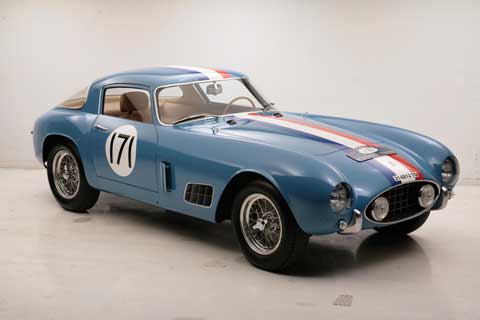
The Tour de Force would have to be the Tour de France. One of the earlier, perhaps more attractive TdFs, this consignment has got to be at the top of our auction dreamlist.
The Ferrari 250 GT Tour de France presented here, chassis number 0563 GT, was sold new by Ferrari SpA to Racing Sport S.r.l of Torino, Italy on September 10th, 1956. Racing Sport then leased the car to Nice resident, Jacques Peron. The fifth Tour de France was held between September 17th to 23rd in 1956 and Peron, with co-driver Jacques Bertrammier took the car to 8th place overall. In October that year at the 12th Coupe du Salon at Montlhéry, Peron finished a fine second place.
In 1957 Peron won the Rallye des Forets in March, showing just how versatile these Ferrari competition cars really are. Victory again in April at the USA Cup at Montléry for Peron was followed by second overall and second in class in the Rallye du Printemps. June saw a class win in the Grand Prix of Paris at Montléry and victory in the Rallye Allier in Algier. The car did not finish the Reims 12 Hours but Peron was back to winning ways in the Razel race, finishing first in class. In September at the sixth Tour de France Peron and co-driver Burggraf finished a tremendous fifth overall. The Coupe du Salon at Montléry was followed by Peron’s last event of the year, the Armagnac Rallye in which he finished third.
1958 saw a more limited season, but highlights were seventh in the Pau 3 Hours and a class win in the Planfoy hillclimb. Late in 1958, 0563 GT was returned by Racing Sport and Peron to Ferrari in Modena.
In November 1959 the car was sold by Ferrari to Bruce Kessler and exported to the U.S.A. In 1960 it was sold to Ron Wakeman from California and in 1973 became the property of Larry Taylor, also of California. In 1983 Richard Gent Jr. bought the car from Taylor’s estate and had it restored by Joe Piscazzi’s Auto Body and Tom Selby. It was shown by Gent at the 25th Annual Ferrari Club of America International Concours at Stouffer’s Pine Isle Resort at Lake Lanier Island, where it placed second.
In the nineties Bob Smith Coachworks in Texas fully restored the car but it was not shown again by Richard Gent until January 2001 at the 10th Annual Palm Beach Cavallino Classic at The Breakers in Palm Beach, Florida. In May of the same year the car won the Forza Award at the 37th Annual Ferrari Club of America National Meeting and Concours at Dallas. The car was last seen at the 53rd Pebble Beach Concours d’Elégance where it finished second in the class for Ferrari competition cars.
Ferrari 250 GT Berlinetta Tour de France, chassis number 0563 GT is one of the most legendary Ferrari dual-use road/race cars. The car is the eighth of nine cars produced with the original body style and the eighth of just seventy-two Tour de France Berlinettas built. It goes without saying that this car is eligible for all the great historic races and events around the world. 0563 GT’s outstanding competition history make this car particularly desirable. These cars rarely come to market and with breathtaking looks, fantastic performance and handling, this has to be one of the most coveted Ferraris in the marque’s history.
1947 Talbot Lago T26 Record Cabriolet Lot 239
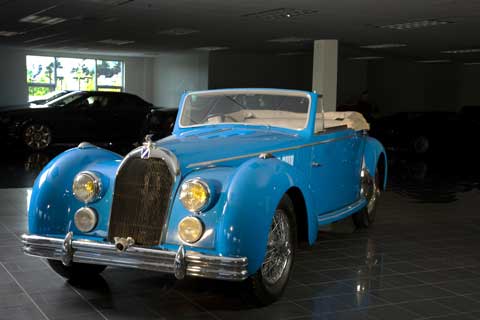
We dream of a Talbot-Lago, built when the racing versions were winning major Grand Prix events and the sports variation placed one and two at the LeMans 24 Hours in 1950.
The example offered here is a T26 Talbot Lago Record, Tony Lago’s postwar premier cabriolet. Although it carries factory coachwork, the design was heavily influenced by the work of renowned French coachbuilder, Figoni et Falaschi.
More importantly, this smooth and reliable proved ideal for luxurious grand touring models, which were equipped with either two Zenith or Stromberg carburetors, independent front suspension, hydraulic brakes and shock absorbers, and 18-inch Rudge-Whitworth wire wheels. Designed as a luxury road car for the elite motoring enthusiasts of Europe, speed and comfort were important. So too was styling, and the new Talbot Lago was shown at many postwar concours events, where it did quite well, just as it does today.
Built in 1947 for a French naval officer, it was delivered December 16, 1948. Well known in French car circles, this spectacular Talbot has benefited from a comprehensive body-off restoration to professional standards by Richard Adatto, a noted marque expert. He reports that no expense was spared to restore the car to authentic condition.
The car was invited to Pebble Beach in 1992 and won Best in Class in the Talbot Lago Class, against a highly competitive field that year. It was judged by French judges and was considered the most authentic postwar Talbot of its genre. At the Classic Car Club of America’s Grand Classic in Seattle in 1994, it won its class, was judged 100 points and obtained senior status.
The vendor acquired the car from Mr. Adatto in the summer of 2002. It is well documented and is offered with a copy of the factory build sheet and other reference material. This car is fully capable of performing on today’s highways at speed. In a recent road test, it acquitted itself well, starting easily and running well. The chassis feels light for the time, and the car’s acceleration and handling make it a pleasure to drive
The Talbot Lago features a 170hp, 4,482cc seven main bearing hemispherical head twin cam inline six-cylinder engine, Wilson pre-selector transmission, independent front suspension, and four wheel hydraulic drum brakes.
1982 Ferrari 308 GTB Race Car Lot 415
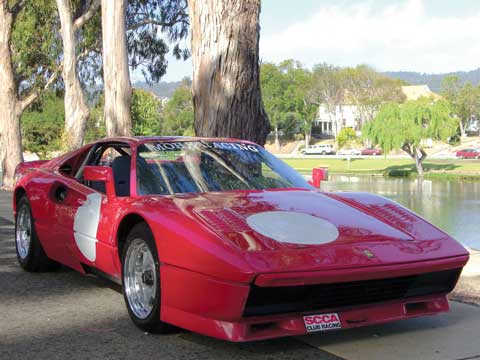
At the other end of the spectrum, what to do with an old 308. More fun than profit, but money’s not everything.
No one is exactly sure how much was originally invested to make the Ferrari pictured here what it is today, but in order to save a marriage, the figure of $140,000 was all that was recorded during the construction of this one of a kind, race-ready 348 hp Italian rocket. Built over a period of several years in the early 1990s it was completed in 1994 and started to dominate the competition immediately.
Starting with a solid chassis clad in the fiberglass body panels of a Ferrari 288, it was fitted with an SCCA approved integral roll-cage added for driver safety. Herman Thelier of Thelier Automotive Technik in La Habra, California was responsible for the entire construction, making this already potent Ferrari that much more venomous to those it raced against. Keeping things simple, the engine was fitted with a carburetor setup that added nearly 25 more horses than the factory specifications, while a combination of Tilton and Wildwood brake components make sure that this stallion can stop as well as it can go. Tuning the suspension for maximum performance, a set of Blue Koni shocks were used, the same style as on the Ferrari 333SP, while another Ferrari legend, the 355, contributed its excellent steering rack for instant response from the driver. Another major plus is an SCCA approved fuel system that was all in order when it was originally built and campaigned. A lightweight vehicle, this super 308 tips the scales at just over 2,100 pounds and the owner tells us that it would just be a minor exchange of a few parts to make this car street legal.
Most would agree that keeping it in its current racing livery would be so much more fun. With just seven hours of run time on the engine since its completion, the Ferrari has been quite productive and would remain so for quite some time. With seven outings, most at Laguna Seca, where it competed in GT2 classes, the 308 has proven quite successful, garnering a 1st place win in June of 1995 plus a pair of second place finishes, and as a bonus another overall first at an October 1995 event held at Infineon. Included with the purchase of this car is the trophy plus the official SCCA log book.
Offered Without Reserve
1961 Facel Vega HK500 Lot 225
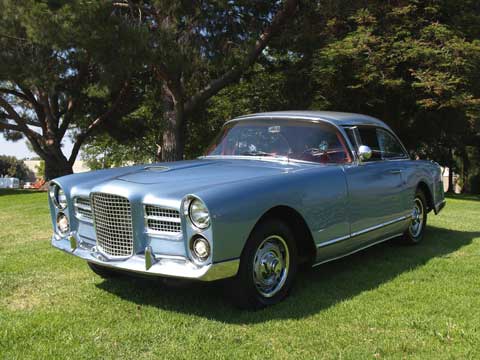
It is in the early 1960s, and Yves Montand is driving his Facel Vega down the Champs Elysées. Or perhaps it could be you, today, same car, same place.
As a follow-up to the original Facel Vega, the HK500 was designed to compete with the best grand touring cars on the market at the time. Promotional literature claimed that the HK500 could out-perform the Mercedes-Benz 300SL, the Aston Martin DB4 and the Ferrari 250GT. Stylistically, it featured a wrap-around windshield, a forward-canted front fascia and dramatic rear fenders.
Its style continues to impress even the contemporary media: Automobile Magazine recently named it one of the 100 “coolest cars ever.â€
This HK500 was purchased by its first owner in Switzerland and then spent a few years in Paris before it was bought by an American in San Francisco – its second and current owner. It was refinished in a shimmering silver blue with a silver top and rockers, a unique period combination. Steel wheels with knock-off style hubcaps and chrome trim rings give it a decidedly European appearance. The original interior features beautifully worn red leather and well-preserved burled wood trim throughout – its patina is extraordinary. A full vintage tool kit sits in the well-kept trunk. It was the first of 55 HK500s built for 1961, adding a unique twist to its undoubted rarity.
While early HK500s featured a 361 cubic inch V8, the later 1961 model presented here is powered by a 360 horsepower 383 cubic inch (6286 cc) 90-degree Chrysler V8 mated to an automatic transmission, a combination that was claimed to be capable of propelling the car up to a top speed of 135 miles per hour.
An immensely drivable example, the HK500 will undoubtedly please its next owner with an elegant combination of rarity, performance and preserved style.
Mechanically, the Facel Vega features a 360hp, 383 cu. in. Chrysler V8 engine, twin four-barrel Carter carburetors, Chrysler three-speed TorqueFlight automatic transmission, coil spring/A-arm front suspension and solid axle with leaf springs in the rear, four-wheel Dunlop disc brakes. Wheelbase: 105″
1952 Alfa Romeo 1900C Berlinetta by Touring Lot 417
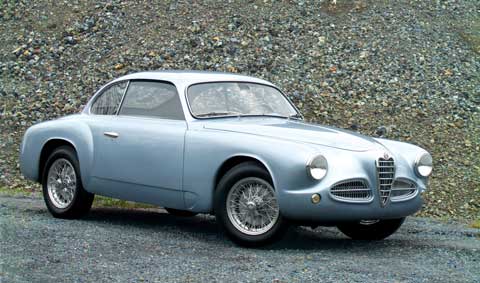
The classic lines of the 6C2500 Villa d’ Este were adapted to the later 1900 Alfa series with considerable success. One of our favorite postwar Alfas.
This lovely five-window Superleggera Berlinetta is one of 650 first-series examples produced from 1951-53 by Touring, greatly prized as the purest form for the model, featuring the highest level of bespoke detail. This car was the subject of a three-year-plus nut and bolt restoration by noted Italian car specialists RPM (Restoration and Performance Motors) in Vergennes, Vermont. No component was neglected, from a bottom-up engine rebuild, transmission, suspension, interior and trim, to the 12-coat final finish. Each step was exhaustively researched for authenticity, down to the signature Touring rosewood and aluminum steering wheel. There is a comprehensive photographic history of this epic restoration available with the car, and it was documented with a six-page ‘Restoration Profile’ in the January, 2006 issue of Hemmings Sports & Exotic Car magazine. (The car was then featured as the May image for their 2007 calendar.)
Today, with its stunning ice blue paintwork, complemented with an interior in monochromatic shades of blue and set off by its gorgeous Borrani wire wheels (one of the last original NOS sets available anywhere), this Alfa is elegance incarnate. Although the 1900C featured the shift lever on the steering column, it was a popular period modification to relocate it as a floor shift. This car is so equipped, adding to the owner’s driving pleasure on each of the several rallies in which it has participated including the 1000-mile Forza Amelia. Of course it is eligible for virtually any road event on the planet including the Mille Miglia Storica.
Presented in show-ready condition, the car has twice been invited to and shown at the Amelia Island Concours. Also two-time Best of Show winner from the Saratoga Auto Museum, it has won numerous awards. This car is complete with a correct spare on a Borrani wheel and includes a full record of the meticulous restoration.
The Alfa 1900 Touring features a 100bhp 1,884 cc twin cam inline four-cylinder engine, downdraft Solex carburetor, four-speed floor shift manual transmission, coil spring and double A-arm independent front suspension, solid rear axle with longitudinal radius arms and triangular lateral locator, coil springs and tubular hydraulic shock absorbers, four-wheel drum brakes. Wheelbase: 98.5″ (2,500mm).
1936 Bugatti Type 57 Stelvio Lot 106
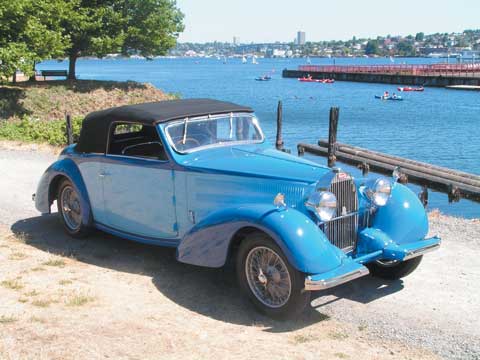
Ken Purdy wrote, “Imagine a string straight, poplar lined Route National…that growing dot in the middle distance is a sky blue Bugatti rasping down from Paris to Nice at 110 mph..â€
From early 1934 until the outbreak of the war in September 1939 the automotive output from Bugatti’s Molsheim factory was almost exclusively devoted to the Type 57 model and its later variants.
The 3.3-liter engine was completely new, with a five-bearing crankshaft at the back of which a train of helical gears drove the twin overhead camshafts. Although it retained fixed heads, the cylinder block was a single symmetrical casting providing classic hemispherical combustion chambers. Instead of the inverted bucket tappets of the earlier Miller-influenced Type 50, the new engine featured valve actuation by fingers interposed directly between the cams and their respective valves. The gearbox was also a completely new design with constant-mesh dog-engagement for second, third and top gear. And instead of being a separate unit as before, the transmission was mounted directly to the engine by a conventional bell-housing containing a normal single-plate clutch instead of the previous Bugatti multi-plate unit.
Before 1927 the Bugatti factory had not produced coachwork for their own cars, if one discounts the racing bodywork of the Type 35, its variants and other early racing models. But thereafter they developed an increasing in-house capacity to produce their own traditional timber-framed coachwork, initially for the Grand Sport versions of the Types 40 and 43. From around 1930 Jean Bugatti was to play an increasingly important role as a stylist, working in conjunction with chief coachwork designer Joseph Walter.
For the new Type 57 model the factory offered from the outset a choice of the Galibier four-door saloon, the Ventoux two-door coupe and the Stelvio cabriolet, although the latter was in fact built by local coachbuilders Gangloff of Colmar. Alternatively, the cars could still be supplied in completed rolling chassis form so that their agents or clients could select their own coachbuilder from whom to commission coachwork to their own personal requirements.
The 1936 Bugatti Type 57 Stelvio presented here is finished in two-tone blue with coachwork by Gangloff. The Type 57 was originally purchased in February 1936 in Belgium by a man named a M. Solet. Over the years the Bugatti changed ownership several times, but for thirty years and until recently, the car belonged to Henry Schafer of Princeton, N.J. Included is a comprehensive folio documenting a complete body off restoration undertaken in the late 1980s by Mr. Schafer. Today, the Bugatti retains its original body, gearbox, and motor, as well as a documented history from new.
Hi Pete:
I won’t be able to make Pebble et al. this month. Please pick up that Alfa for me at the auction! Thanks.
Best,
David
Hi Pete
At the risk of being a complete smart ass, unless the HK500 was a marked departure from previous models, the apparent wood trim was paint applied in a particular manner and, if my memory is correct (probably not) also by one person throughout the existence of the make.
Cheers
Adrian
Hi Pete,
I don’t see any particular value in the 308. It is, after all, nothing more than a home built (although very expensive to build) club racer w/o provenance. Yes, it has a few SCCA trophies, but GT2 in that era here on the coast was often about only three or four entries…that said, it will be interesting to see what happens at auction. I’ll be there, and intrigued by what happens to it.
Cheers,
Tom